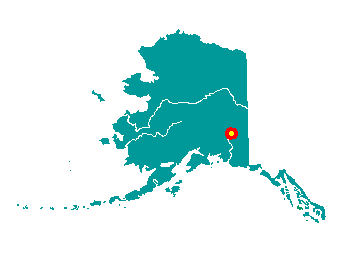 The
Native Village of Dot Lake, a traditional Upper Tanana Athabascan
village, is located south of the Tanana River, two-tenths of a mile
southeast of the Alaska Highway, 50 miles northwest of Tok and 155 road
miles southeast of Fairbanks. The population as of 2011 was 55.
The
Native Village of Dot Lake, a traditional Upper Tanana Athabascan
village, is located south of the Tanana River, two-tenths of a mile
southeast of the Alaska Highway, 50 miles northwest of Tok and 155 road
miles southeast of Fairbanks. The population as of 2011 was 55.
Archaeological evidence at nearby Healy Lake revealed more than
10,000 years of human habitation. Dot Lake was used as a seasonal
hunting camp for Athabascans from George Lake and Tanacross. A Native
freight trail ran north to the Yukon River through Northway, Tetlin,
Tanacross, and Dot Lake. During construction of the Alaska Highway in
1942-43, a work camp called Sears City occupied Dot Lake's present
location. Several local Natives worked on the road project.
The Native village was settled by Doris Charles and her family in
1946. Between 1946 and 1950, other families moved permanently to Dot
Lake from George Lake, Sam Lake, and the Tanacross area, obtaining
homesites or Native allotments. Some of the old work camp structures
were converted into homes. In 1971, seven new homes were constructed
along the lake. The Dot Lake Native Corporation developed a
shareholder's subdivision, consisting of 53 one-acre lots. In 1994 and
1996, nine additional Indian Housing Authority homes were built.
Employment in the area is limited to the village council, Tanana
Chiefs Conference, and the school. Parkas, moccasins, beadwork, and
other handicrafts are sold by local residents. In the summer, the BLM
hires firefighting crews. Subsistence activities are particularly
important -- moose, ducks, geese, ptarmigan, porcupines, caribou,
whitefish, and other freshwater fish are utilized. Salmon are primarily
obtained from the Copper River area, where a number of residents have
extended families.